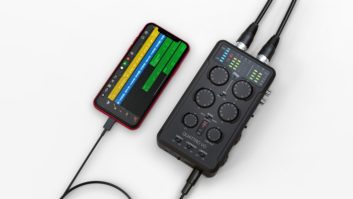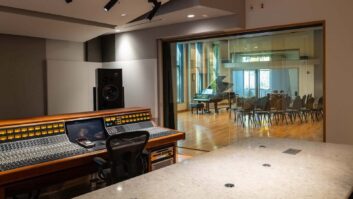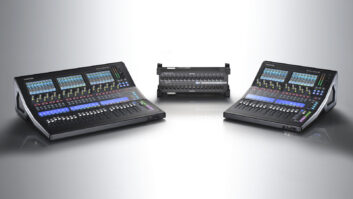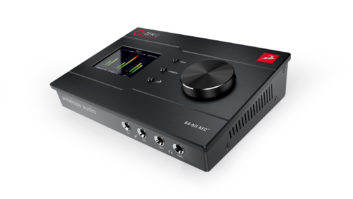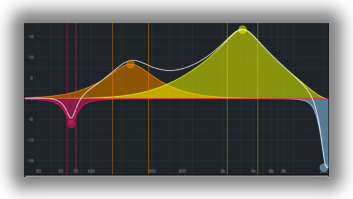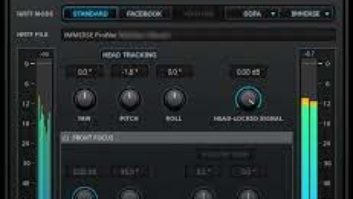This month, we investigate choices within the category of multichannel preamplifier units featuring I/O. Other than microphones, studio monitors and/or headphones, today’s comprehensively featured preamp-I/O units have become the hardware of choice for modern production studios, serving as portals for, ideally, near-zero round-trip latency as well as connectivity with other components—an analog and digital hub, where all associated connections meet.
Here we detail the market’s most attractive options in combination preamp and I/O units, listed in alphabetical order. As this article was completed before 2018’s annual Winter NAMM Show, some qualifying brand-new and/or embargoed products may not be listed below. Trust that we will report on such units in the very near future.
Antelope Audio has unveiled its Discrete 8 Thunderbolt and USB Interface, as well as the accompanying Edge and Verge modeling microphones. Discrete 8 is a 26-input/32-output interface that offers eight console-grade, fully discrete preamps plus Antelope Audio’s real-time FPGA effects, which are models of outboard processing from BAE, Gyraf Audio and Lang, among others. Using Antelope Audio’s all-new ConnectAFX plug-in, these effects are accessible via any DAW. Built to be used with Antelope modeled processors, the new modeling microphones are available as Edge large-diaphragm multipattern condensers with dual edge-terminated capsules and Verge small-diaphragm condensers. The Discrete 8’s Accusonic 3D Modeling Engine enables users to transform both Edge and Verge mics into vintage-style replica transducers with control over proximity effect, off-axis response, and even post-recording polar pattern changes.

Historically, Apogee has served recordists working within MacOS exclusively, but late last year, the company announced Windows 10 compatibility for its USB interfaces, including the 4-channel Quartet USB audio interface. The new Windows software installers include a firmware update for the hardware, custom Apogee ASIO audio driver and PC-compatible version of Apogee’s Maestro application for controlling settings and low-latency monitoring. Meanwhile, Apogee continues to ship its notably cost-conscious Element Thunderbolt audio interfaces for Mac, the 192kHz/24-bit capable Element 24, Element 46 and Element 88. Element 24 offers 10-in, 12-out; Element 46 offers 12-in, 14-out; and Element 88 offers 16-in, 16-out. Element units perform a 1.41 ms roundtrip latency at 96 kHz with a 32-buffer setting when using Apple’s Logic Pro X DAW.
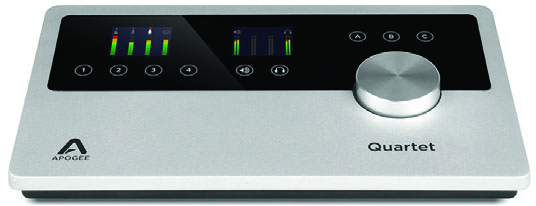
The Avid PRE is an 8-channel digitally controlled preamplifier that is adjustable from its front panel or entirely within Pro Tools, or an associated Avid controller. Each input supports XLR, DI or TRS line-level inputs. DB-25 outputs are provided for universal analog connectivity, too. All eight channels are provided insert points as well as highpass filter, phase reversal and 48V phantom power.

Affordable and well-equipped with I/O options, Behringer’s Firepower FCA1616 is a 16-in, 16-out 24-bit/96kHz-capable multichannel preamplifier/interface featuring FireWire, USB, MIDI, ADAT, S/PDIF, etc., connectivity. Key features include four Midas-designed preamps with phantom power, individual pad, low-cut and high-impedance selectivity, eight analog inserts, and much more. Most attractively, the unit is priced at a low $249.99 street.

DiGiGrid IOS, an audio interface with a built-in SoundGrid DSP server for plug-in processing developed by Waves and DiGiCo, features 8 mic/line inputs, 8 line outputs, dual headphone outputs, and MIDI I/O, S/PDIF, and AES ins and outs. Connectivity is via a single Ethernet cable (Cat 5e/Cat 6). Notably, IOS comes with SoundGrid Studio System software, including the SoundGrid Studio application, StudioRack, and the eMotion ST mixer. This allows mixing and monitoring, in real time, with SoundGrid-compatible Waves and third-party plug-ins with incredibly low latency (0.8 milliseconds).
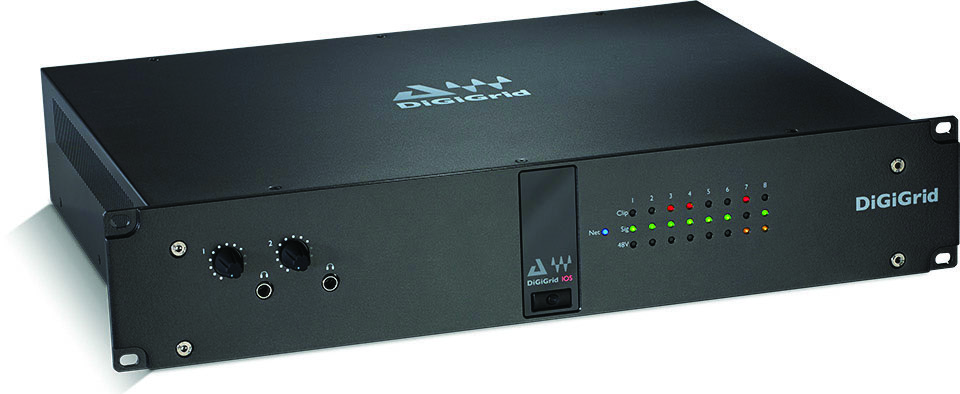
ESI Audiotechnik GmbH—a branded and OEM pro audio design/manufacturing firm since 1998—is shipping its 24-bit/96kHz-capable U168 XT and U86 XT USB audio interfaces. Mac or PC-ready, the U168 XT ($499 street) provides four microphone preamps via front-panel XLR inputs with phantom power, two of which are switchable Hi-Z instrument inputs (with XLR/TRS combo jacks); 16 line inputs and 8 line outputs via 1/4-inch TRS, all on the rear panel; S/PDIF I/O via RCA connectors; dual headphone outputs with individual gain adjustment; L/R mix outputs via 1/4-inch TRS; 16-channel MIDI I/O; and USB 2.0 port. Smaller than its full 19-inch-wide sibling, the U86 XT is identical to the U168 XT, only with fewer I/O points.

Focusrite’s new and cost-effective Clarett USB Series includes the Clarett 4Pre USB, a four-preamp, 18-in/8-out unit; and the Clarett 8Pre USB, an eight-preamp, 18-in/20-out unit. The series boasts up to a 119dB dynamic range, is Mac- or PC- compatible, and includes Focusrite’s proprietary Air-enabled preamps. Other features include MIDI I/O, ADAT input, S/PDIF I/O and two headphone outputs with volume controls.

Meanwhile, Focusrite’s largest multichannel preamp in its Red Series, the 8Pre, offers a whopping 64 ins, 64 outs and eight digitally controlled Red Evolution mic pre’s with 63 dB of gain. With 16 analog inputs and 18 analog outputs, the unit also includes two front-panel instrument inputs. Further, its connectivity is impressive—options of Thunderbolt 2, dual Pro Tools | HD DigiLink, and Dante AoIP are included.
Grace Design’s m108 is a high-performance 8-channel preamp with eight inputs and two outputs featuring USB 2.0 connectivity. Evolved from the beloved m802, its eight transformerless mic preamps feature 192kHz A/D conversion. Dual 1/4-inch Hi-Z inputs for channels 1 and 2 are included, plus 1/4-inch stereo headphone output with dedicated volume control. Buttons for +48V phantom power, mute, phase reverse, solo, Peak Clear, setup, Group and Pan control are included on its front panel. A high-contrast OLED displays all the functionality of the eight preamp channels and associated Global settings. An Edit knob controls the m108’s functions and allows navigation around the setup menu. Other features include DB-25 analog out, AES3 out, dual ADAT outputs, Word Clock I/O, RS422 MIDI I/O for Pro Tools HD control, and an Ethernet jack for IP control.

Priced at $579 direct, Keith Mc-Millen Instruments’ truly unique K-Mix is all of the following: a USB bus-powered 8-in/10-out interface featuring dual proprietary μPre preamps, a programmable multichannel mixer featuring per-channel DSP, and an intuitive, lightweight MIDI control surface featuring no moving parts and cool backlit parameters. For recordists needing no more than two microphones at any given time alongside multiple line level inputs, the all-in-one K-Mix may be just the right product.
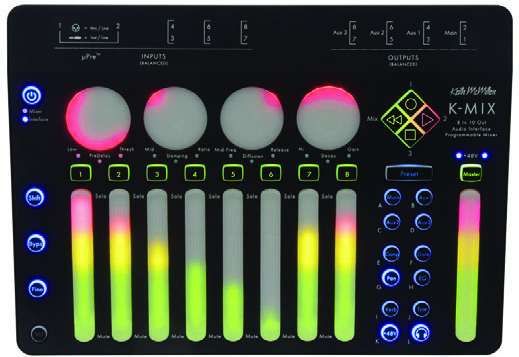
Millennia Media’s HV- 3R is the remote-controllable version of its HV-3D 8-channel multichannel microphone preamplifier. Controllable via Ethernet on Millennia’s AELogic PC software, as well as via MIDI, the HV-3R has available Dante, AES and MADI output options, too. For world-class, large-channel count purposes, the HV-3R is matchless; the unit supports control of up to 792 channels (or 99 HV-3R units) simultaneously.

MOTU has redesigned its venerable 828 interface, re-launching it as the 828es Thunderbolt/USB for Mac, PC and iOS platforms. Features include 28 inputs and 32 outputs, including two redesigned mic/line combo preamps with front panel and remote control of individual gain/pad/48V phantom power; in total, it offers 60 channels of I/O, 48-channel mixing and 32-bit floating point DSP effects processing. Housed in a 1U chassis, it has eight balanced (TRS) analog in/out (with DC coupled outputs), separate main outs on XLR jacks, two banks of 8-channel optical I/O (switchable to stereo TOSLink), RCA S/PDIF digital I/O, and two independent front-panel headphone jacks with volume controls. It also features a built-in talkback mic with front-panel Talk button and A/B monitor select, mute and sum-to-mono buttons for the main outs.

PreSonus’ flagship I/O device, Quantum ($999 street), is a 26×32-channel, Thunderbolt 2-ready unit. Quantum provides 24-bit, 192kHz converters with 120 dB of dynamic range and the company’s proprietary recallable XMAX microphone preamps. For more I/O channels, users may simply combine up to four Quantum interfaces via Thunderbolt to create a 96×96 I/O rig. Key features include two combo mic/instrument/line inputs (via front panel) and six combo mic/line inputs (via rear panel), each with a digitally controlled XMAX preamp and +48V phantom power; two TRS main outputs, eight 1/4-inch TRS line outputs; two independent headphone outs with dedicated volume controls; ADAT Optical I/O and S/PDIF stereo digital I/O; BNC word clock I/O; MIDI I/O; onboard talkback mic; Mute/Dim and Mono controls; a full version of PreSonus’ Studio One Artist DAW, PreSonus’ UC Surface control software (allowing use of third-party recording software while fully accessing Quantum’s deep features); and the Studio Magic Plug-in Suite with seven plug-ins in VST, AU and AAX format.

German manufacturer RME regularly packs mind-blowing amounts of features and functionality into a 1U chassis. Last year, I reviewed the Fireface UFX+, capable of handling up to 94 channels of I/O while offering USB 3.0 and super-low latency Thunderbolt connectivity. Key features include four microphone preamps with 75 dB of gain; MADI I/O; built-in TotalMix FX mixer for input, output, mix level, etc., control; and available ARC USB desktop controller. Most notably, the RME doesn’t even need a CPU to capture multitrack audio; users may simply insert a thumb drive into its front panel DURec USB slot for capturing up to 76 simultaneous channels. I was floored by its capabilities, pristine sonics and mighty DSP power.

Steinberg’s stalwart UR824 is a 24-bit/192kHzready USB 2.0 audio interface featuring 24-in/24-out functionality and eight D-PRE microphone preamps with dspMixFX, a latency-free DSP-powered monitoring system with REV-X reverb, Sweet Spot Morphing channel strip and various guitar amp simulations. Although Cubase and Cubasis DAWs are included, the UR824 is compatible with all major DAWs. Its two pairs of ADAT optical I/O provide 16 ins and outs, which are S/MUX-compatible, 4-in and 4-out at 192 kHz.

Tascam’s 24-bit/192kHz-capable Celesonic US-20×20 offers 20 channels of analog and digital I/O paired with USB 3.0/2.0 connectivity for an affordable $499 street. Built to serve in a number of applications, the US-20×20 operates as an audio interface, digital mixer and 8-channel digital mic preamp. The unit features Tascam’s Ultra-HDDA microphone preamps with 56 dB of gain; ten channels of digital I/O via ADAT and S/PDIF connectors; word clock and MIDI I/O; and a built-in DSP mixer with parametric EQ and compression on every channel. The unit also includes a stereo reverb.
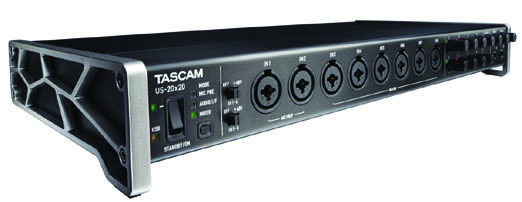
Universal Audio’s Apollo 8p features eight Unison-enabled mic preamps, onboard UAD-2 QUAD Core processing, and—as to be expected—an included bundle of award-winning UAD plug-ins. Apollo 8p offers 16 ins, 20 outs, and two built-in Thunderbolt ports. UA users can quickly increase the number of inputs by adding other Apollo units into the system. UA’s Console 2.0 application allows comprehensive control of what’s going on inside the Apollo 8p.
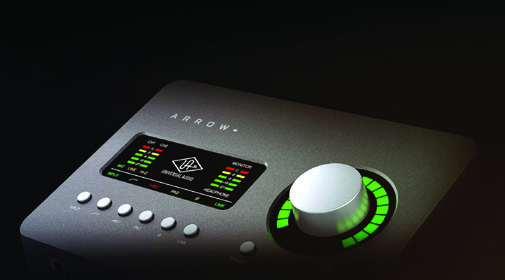
Zoom’s TAC-8 is a Mac-ready 24-bit/192kHz-capable 18-in, 20-out Thunderbolt interface featuring eight microphone preamps with a wide range of uses. In stand-alone mode, it can be used simply as an 8-channel mic preamp and A/D or D/A converter, no CPU needed. Other features include 10 balanced TRS output jacks, dual front-panel headphone outputs with dedicated volume knobs, ADAT and S/PDIF I/O, Word Clock and MIDI I/O, and much more.

Strother Bullins is a pro audio technologist and educator.
